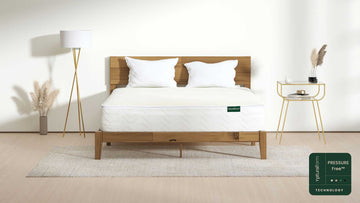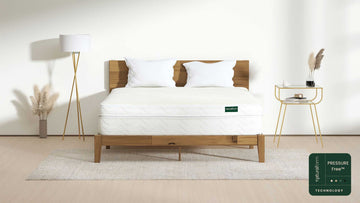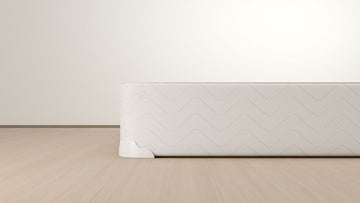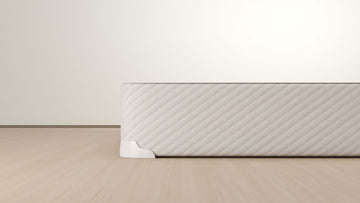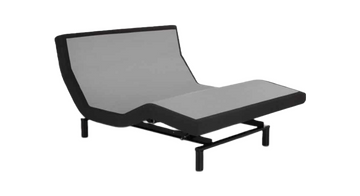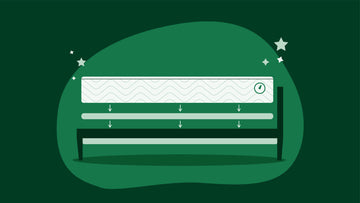When you need support for your bed, you might consider a bunkie board. Also spelled bunky board, they can provide an alternative to standard box springs. If you’ve never heard of a bunkie board before and aren’t sure if you need one, this guide will help you to understand what they are and what they’re for. Let’s take a look at some of the key things that you need to know about bunkie boards.
What is a bunkie board?
A bunkie board is a barrier that is designed to fit between your mattress and your bed (or any other surface your mattress might be resting on). You can use it with bed frames, bed platforms, box springs, and slatted foundations. They usually measure around 1 to 3 inches thick and were originally made from a single piece of wood covered in fabric, but now tend to be made from particleboard or plywood, with wood chips or strips of wood put together to form the desired size. Bunkie boards are cost-effective and offer a strong and solid platform to support your mattress.
A short history of bunkie boards
The name bunkie board comes from the fact that they were first made for bunk beds. Box springs are too large to use with tall bunk beds, so thinner supports were created in the form of bunkie boards. Now they are available for every size of bed, not just bunk beds, and can offer a low-profile and space-saving way to support your mattress. The bunkie board has come a long way since it was first created, and you can now even find decorative options if you’re looking for a bunkie board that matches your bedroom decor. Plenty of people still use bunkie boards and they’re a great option for your bed.
Bunkie board construction
Pick a secluded spot for yourself, so you can avoid any disruptions while sleeping. Then, practice progressive muscle relaxation to calm your entire body. You can do this by tensing and then relaxing all of your muscles, starting from your toes and moving up to your neck and head. This physiological process precedes sleep, and replicating it prepares your body to sleep with your eyes open.
Plywood
Plywood is the material that you are most likely to find when looking for a bunkie board. Plywood is made from thin layers of wood veneer glued together to create a material that’s affordable, strong, and looks like wood.
The plywood makes the bunkie board strong and light, which gives it advantages over particle board and steel bunkie boards, respectively. Plywood is also better at resisting moisture compared to particle board, which makes it suitable for anyone who lives in a more humid climate. However, the downside is that plywood bunkie boards are more expensive than particle board, although they can be more affordable than other options.
Particle Board
Particle board or LDF (light density fiberboard) is also used to make bunkie boards. It’s made from waste wood, which makes it a good option for anyone who is eco-conscious and looking for a greener alternative to plywood or solid wood. Particle board is created using heat and adhesives to bind the wood together and chemicals are added to make the material more robust and resistant to moisture, termites, and fire.
If you’re looking for an affordable bunkie board, particle board is your best bet. It’s cheaper than plywood or steel, although it is heavier than plywood and not as moisture-resistant, either. You can get particle board in different grades, with grade A quality being better, but you can often expect to pay more for better quality. If you’re buying a particle board bunkie board, check the grade before buying so you know its quality.
Particle boards are not particularly strong compared to the other material available for a bunkie board. If you just want something cheap or perhaps a temporary support for your mattress, it can be a good choice, but you should consider your other options too.
Solid wood
The first bunkie boards were made with solid wood, although these are slightly less common than they once were. Solid wood is usually very robust and strong, making it a good choice for a bunkie board. You can find that different types of wood are available, with some being more expensive than others. However, there are disadvantages to keep in mind too.
Solid wood is heavier than plywood or particle board and it’s also a more expensive option. Solid wood is less stable too and has a risk of changing shape due to environmental conditions. The wood can expand when it’s humid or contract in drier weather and climates. This could mean that it’s not the right size for the bed.
Steel
A metal bunkie board made from steel is also a possibility. They’re the strongest option, although they are also the heaviest. They are made from steel slats that are held together in a steel frame, rather than being a solid piece like other bunkie boards. Sometimes they also have a fabric cover.
Steel bunkie boards can be best if you need a bunkie board that holds a lot of weight. They’re a good choice for bunk beds or loft beds. Another advantage is that they don’t suffer the same problems as wood, such as the risk of termites, and they’re resistant to fire and water without any special treatment too. They won’t change shape or size due to the temperature or humidity like other materials might.
A significant disadvantage to steel bunkie boards is that they can cause damage to your mattress. They don’t protect the mattress very well, even when they have a fabric cover, and might poke into the bottom of the mattress. Memory foam and latex mattresses, which include many modern mattresses, can be particularly susceptible to this, so they are most likely not suitable to use with a steel bunkie board. Steel bunkie boards can also make more noise when you move, which can be annoying. Another downside is that steel bunkie boards are heavy and more difficult to move and transport. Additionally, they are also more expensive compared to plywood and particle board.
Which bunkie board material should you choose?
As you can see from the descriptions of different bunkie board materials above, they each have their advantages and disadvantages. There isn’t necessarily one better option out of them all. It depends on your needs, the type of mattress, and your budget. Here are some of the factors to consider when you’re choosing a bunkie board:
Weight capacity
Weight capacity is an important factor when you’re choosing a bunkie board. The bunkie board needs to support the mattress, any bedding, and the person or people sleeping in the bed (and maybe the occasional small person or pet!). The weight capacity of a bunkie board can range from around 150 to 500 pounds, depending on its construction.
Steel bunkie boards can hold the most weight, and solid wood boards usually have a high weight capacity too. Plywood has a higher weight capacity than particle board, although it’s not as strong as steel or wood.
Portability
Getting a balance between sturdiness, weight capacity and portability can be tricky. A steel bunkie board might be strong and have a high weight capacity, but it’s also heavy and can be more difficult to move. Plywood is best if you’re looking for something that’s lightweight and easy to move, whether you’re moving house or just like to rearrange your furniture. Some bunkie boards can be folded too, which is great for transport and also for storage.
Durability
A durable bunkie board is a must. You don’t want to have to replace it too often, especially if you’re spending a large amount of money on it. Steel is the most durable option, but it is also heavy and not suitable for some modern mattresses. As an alternative, solid wood and plywood both offer durability. Particle board is the least durable option, especially if you’re looking for a bunkie board resistant to moisture and environmental changes. Solid wood can experience problems too, shrinking or expanding with heat and moisture.
Price
Finally, the cost of a bunkie board needs to be taken into account too. When thinking about your budget, consider the durability of the board too. Particle board and plywood are the two most affordable options, with plywood offering a sturdier base. These can offer you value for money if you’re on a lower budget. Solid wood and steel tend to be more expensive, but they could last longer.
Keep these things in mind if you’re looking for the right bunkie board. You should choose the material and size that meets your needs.
Who needs a bunkie board?
What are the reasons you might choose to buy a bunkie board? Bunkie boards are becoming more popular because of the excellent support they can provide for your mattress and the little space that they take up. Traditional box springs are thicker and some people might not like the look of them, while bunkie boards offer a slimmer and less visible option.
People who might be particularly interested in a bunkie board include those with modern mattresses, such as memory foam and latex mattresses. Although box springs are good for traditional spring mattresses, helping to absorb pressure and offer support, modern mattresses generally aren’t recommended to be used with box springs. These types of mattresses need to have a solid base to prevent them from sagging. You might have a bed frame with a solid base, but you can also add an extra barrier between the frame and the mattress, and bunkie boards are an excellent option. A bunkie board can be placed on your bed frame or foundation to provide you with a solid base for your mattress.
You might need a bunkie board if you need a firm support for your mattress but you have a limited amount of vertical space. They’re also good if you’re on a budget and looking for a more affordable way to support your mattress.
Bunkie board or box spring
Bunkie boards are good alternatives to box springs, but would you be better off with a box spring instead? A box spring or foundation is a fabric-covered wooden box that supports your mattress. They used to have metal coils inside them to provide more cushioning, but today’s mattresses are thicker and don’t need this. Modern box springs simply support your mattress and put it at the right height. A box spring isn’t necessarily essential if you have the right support for your mattress and you’re satisfied with the height of your bed. Bunkie boards can still provide you with support in a simpler way, or they can be used together with a box spring to strengthen it.
Bunkie board or slats
If you buy a bed frame or platform bed, it might have a slatted surface. This can remove the need for a box spring or bunkie board, but not necessarily for all mattresses. Some mattresses might still require extra support, and you can do this by putting a bunkie board between the slats and your mattress. Your mattress manufacturer can tell you if you need to have a solid base to place your mattress on. It’s also important to note that combining a slatted base and bunkie board reduces airflow, which might mean you’re warmer at night.
Where can I get a bunkie board?
You can buy a bunkie board from most places where you would buy a bed or box spring. Big retailers that sell furniture, mattresses, and other bedroom items can help you out and show you a variety of options.
Bunkie board price
The cost of a bunkie board will depend on several factors, including the size and material. It could cost you up to $200, but might also be not much more than $50.
Installing a bunkie board
Bunkie boards are easy to install. They sit on top of the frame or slats of the bed, and the mattress goes on top. You usually won’t be able to see the board under the mattress and it won’t raise the height of your mattress much, either.
A bunkie board can be a great alternative to a box spring. It gives your mattress support with a low profile and can help to save space.
